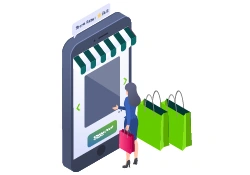Millennial Shopping Trends That Would Benefit Retail Businesses
The retail industry today is experiencing a massive transformation, driven primarily by one demographic force — millennials. Representing one of the largest consumer groups in the world, millennials (born roughly between 1981 and 1996) are rewriting the rules of retail engagement. Their habits, expectations, and digital-first lifestyles are shaping how retailers design, market, and deliver their products.
In India and across the globe, millennials are not just participants in the retail market — they are the primary decision-makers, influencers, and trendsetters. Studies show that nearly 54% of millennials prefer shopping online, while about 40% rely heavily on reviews, influencer opinions, and peer recommendations before making a purchase. This is a generation that is tech-savvy, socially connected, and convenience-driven.
Millennials want more than just products — they seek value, experience, personalization, and ethics in every interaction. For retailers, understanding these evolving preferences isn’t just advantageous; it’s essential to survival.
In this article, we explore the key shopping trends among millennials that modern retailers must incorporate into their business strategies. Each trend reveals actionable insights into how businesses can attract, engage, and retain this influential generation — and how digital retail solutions like Ginesys One empower retailers to stay ahead.
1. Mobility: The Always-On Shopping Experience
Millennials are digital nomads. Their smartphones are at the center of their shopping experience — serving as research tools, comparison engines, and checkout counters. They use mobile devices to browse products, read reviews, compare prices, and even make payments, both online and offline.
In a world where instant gratification rules, mobility isn’t just a convenience; it’s the new normal. Retailers that fail to optimize for mobile risk losing millennial customers to faster, more connected competitors.
a. The Power of Mobile Commerce
Millennials shop from anywhere — on the go, during commutes, or even while watching TV. This constant connectivity demands that retailers offer mobile-optimized websites and apps with seamless navigation, fast load times, and intuitive interfaces.
Mobile commerce, or m-commerce, has grown exponentially in India, driven by widespread internet access and affordable smartphones. Millennials expect their entire buying journey — from discovery to delivery — to be accessible on a screen that fits in their palm.
b. In-Store Mobility and mPOS Solutions
While online sales are booming, brick-and-mortar stores still matter — especially when they merge digital convenience with physical experience. Mobile POS (mPOS) systems are redefining in-store shopping by enabling sales associates to assist customers, manage stock visibility, and process transactions on the floor.
Solutions like Zwing POS, part of the Ginesys One suite, empower retailers with real-time billing and inventory visibility on handheld devices. With Zwing, associates can scan products, check availability, and complete payments instantly — minimizing queues and improving engagement.
c. Omnichannel Mobility Through Ginesys One
Mobility today extends beyond devices — it’s about creating a unified shopping experience across all channels. Whether a customer browses online, shops in-store, or buys through social media, their journey should remain consistent.
Ginesys One, through its integrated suite (Ginesys ERP, Ginesys POS, Ginesys OMS powered by Browntape, and Zwing POS), bridges this gap. It ensures that inventory, pricing, and order data remain synchronized across every sales touchpoint. Retailers can manage online and offline orders in real-time, enabling a truly mobile-first retail ecosystem.
d. Self-Checkout and Contactless Convenience
Millennials prefer speed and autonomy. Self-checkout kiosks and contactless payment systems meet that expectation perfectly. By integrating QR code billing, UPI payments, and digital receipts, retailers can reduce friction and enhance satisfaction.
In summary, mobility means being available wherever your customer is — on any device, at any time. Retailers who invest in mobile infrastructure today are building loyalty for tomorrow.

Upgrade to an integrated suite that delivers seamless mobility across channels.
2. Social Media Engagement: Where Shopping Meets Storytelling
For millennials, social media is the new marketplace. Platforms like Instagram, YouTube, Facebook, and even WhatsApp have become powerful retail ecosystems, influencing purchase decisions and driving brand loyalty.
Unlike previous generations, millennials don’t rely on traditional advertising. They prefer authentic recommendations, influencer opinions, and visual storytelling. They buy from brands that talk to them, not at them.
a. From Brand Presence to Brand Personality
Having a social media page isn’t enough — it’s about creating a voice that resonates. Brands must build communities, not just audiences. Engaging content, behind-the-scenes videos, relatable memes, and live sessions can humanize a brand and foster stronger emotional connections.
Retailers can use data insights from Ginesys One’s InsightX to analyze what their audience interacts with most — helping them refine campaigns and personalize outreach.
b. The Power of Reviews and Social Proof
Millennials rely heavily on online reviews. Nearly four out of five won’t buy without first checking what others have said. Encouraging satisfied customers to leave positive reviews builds credibility and boosts visibility on digital marketplaces.
By connecting Ginesys OMS with online channels like Flipkart, Amazon, and Myntra, retailers can easily manage customer feedback, streamline responses, and monitor performance metrics across platforms.
c. Influencer Collaborations and User-Generated Content
Influencer marketing continues to thrive among millennial audiences. Micro-influencers, in particular, are seen as trustworthy and relatable. Retailers can collaborate with these voices to reach niche communities effectively.
Encouraging customers to share experiences through user-generated content (UGC) — photos, unboxing videos, or testimonials — creates authentic advocacy and expands reach organically.
d. Shoppable Social Media
Platforms like Instagram and Facebook have introduced shoppable posts, allowing users to purchase directly from social feeds. Integrating such channels with your order management system ensures smooth fulfillment.
With Ginesys One’s OMS integration, every social order syncs in real-time with your inventory and ERP — preventing overselling and ensuring timely delivery.
In essence: Social media isn’t just a platform for engagement — it’s a revenue engine when combined with the right technology and authenticity.

Leverage unified insights and seamless channel integrations to boost conversions.
3. Experiential Retail: Beyond Products, Toward Memories
Millennials are not satisfied with mere transactions; they crave experiences. They want to touch, feel, explore, and emotionally connect with the brands they buy from.
In an age where everything is available online, the physical store’s value lies in its ability to create memorable experiences. Experiential retail is about transforming stores from transactional zones into interactive playgrounds.
a. The Shift from Product-Centric to Experience-Centric Retail
Gone are the days when product features alone could win customers. Millennials expect more — they want a brand story, sensory engagement, and emotional resonance.
For instance, cosmetic brands now use AR mirrors that allow virtual try-ons, while sportswear brands incorporate interactive simulators where customers can test gear in action.
These experiences make shopping fun and Instagram-worthy — turning visitors into voluntary brand promoters.
b. The Role of Technology
Technology powers experiential retail. Tools like augmented reality (AR), virtual reality (VR), AI-driven recommendations, and digital kiosks make the journey engaging and personalized.
Retailers using Ginesys ERP and POS can unify product data, availability, and offers across digital touchpoints, enabling personalized in-store recommendations. Zwing POS supports interactive digital displays and real-time promotions, allowing brands to tailor in-store experiences dynamically.
c. Personalization as the Core of Experience
Millennials love feeling special. Personalized greetings, curated product suggestions, and loyalty rewards create emotional attachment.
Through InsightX, retailers can access deep analytics on customer behavior, purchase frequency, and preferences — turning data into actionable insights for personalized experiences.
d. The Emotional Connection
Emotions drive millennial purchases more than logic. A sustainable story, a memorable store design, or a brand that aligns with their values can convert first-time buyers into lifelong advocates.
The takeaway: Retailers that blend creativity, technology, and empathy will win millennial hearts — and their repeat business.

Connect ERP, POS, and digital touchpoints for a unified retail journey.
4. Sustainability and Ethical Consumption: Conscious Commerce
Millennials are leading a shift toward ethical and sustainable consumption. They care deeply about environmental impact, labor ethics, and brand integrity.
This generation prefers brands that demonstrate responsibility — from using recyclable packaging to ensuring transparent supply chains. According to Nielsen, over 70% of millennials are willing to pay more for sustainable products.
a. Green Retail Practices
Retailers can adopt eco-friendly packaging, energy-efficient lighting, and paperless billing through digital receipts — features supported by Ginesys POS and Zwing POS.
b. Transparency and Traceability
Modern ERP systems like Ginesys ERP make it easier to track supplier compliance, manage sustainable sourcing, and maintain visibility throughout the production cycle. By showcasing these efforts, retailers can build millennial trust and differentiate themselves in the marketplace.
c. Cause-Driven Marketing
Brands that contribute to social causes — such as supporting artisans, donating proceeds, or reducing waste — resonate strongly with millennials. Retailers should communicate these values clearly on their platforms and product packaging.
In short: Sustainability isn’t a marketing gimmick anymore — it’s a core expectation among millennial shoppers.
How Ginesys One Powers Retail for the Millennial Generation
To keep up with millennial trends, retailers need a robust digital foundation — one that connects every touchpoint from the supply chain to the customer’s screen. This is where Ginesys One becomes a game-changer.
Ginesys One is an integrated retail and e-commerce technology suite designed to unify all aspects of retail operations. It comprises:
- Ginesys ERP – For comprehensive inventory, procurement, and finance management.
- Ginesys POS – For seamless in-store billing and inventory tracking.
- Ginesys OMS (powered by Browntape) – For multi-channel online order and marketplace integration.
- Zwing POS – A mobile POS and web POS (Cloud POS) solution for next-gen retail mobility and store engagement.
- EaseMyGST – For simplified GST filing and compliance management.
- InsightX – For advanced analytics and data-driven decision-making.
Together, these components help retailers manage everything — from supply chain efficiency to customer experience — ensuring they can meet millennial expectations across every channel.
With real-time data synchronization, cloud-based mobility, and AI-powered insights, Ginesys One empowers brands to become agile, omnichannel-ready, and customer-centric.
Millennials have redefined what it means to shop. They expect retail experiences that are mobile, social, experiential, and ethical — all connected seamlessly across channels.
Retailers that understand and respond to these expectations stand to gain not just sales, but loyalty, advocacy, and long-term growth.
With comprehensive platforms like Ginesys One, businesses can unify their online and offline worlds — managing inventory, POS, GST compliance, analytics, and order processing effortlessly.
The future of retail belongs to brands that merge technology with empathy, innovation with authenticity, and commerce with conscience. Millennials are not just buying products; they’re buying into values — and the retailers who reflect those values will lead the next retail revolution. Get in touch with our experts today!
FAQs: Understanding Millennial Shopping Trends
1. Why are millennials so crucial for retail businesses?
Millennials form a major consumer segment globally. Their digital habits, preference for convenience, and ethical outlook influence every retail trend today.
2. How can retailers attract millennial shoppers?
By adopting mobile-first strategies, engaging authentically on social media, offering personalized experiences, and committing to sustainability.
3. What role does social media play in millennial shopping?
Social platforms drive product discovery, reviews, and purchases. Millennials often trust influencer recommendations and peer feedback more than ads.
4. How does Ginesys One help retailers serve millennial customers?
Ginesys One unifies ERP, POS, OMS, and analytics to create seamless omnichannel experiences, real-time visibility, and personalized interactions.
5. What is experiential retail and why does it matter?
Experiential retail turns shopping into an event — using technology, design, and personalization to create emotional connections and loyalty.
6. Are millennials willing to pay more for sustainable products?
Yes. Studies show over 70% are willing to spend extra for eco-friendly and ethically produced goods.
7. What is the role of data analytics in understanding millennials?
Tools like InsightX help retailers analyze behavior patterns, preferences, and trends — enabling more targeted, impactful engagement.
8. How do Ginesys POS and Zwing POS enhance the in-store experience?
They streamline billing, enable mobile checkouts, reduce queues, and provide real-time stock insights, making in-store interactions smoother and faster.

